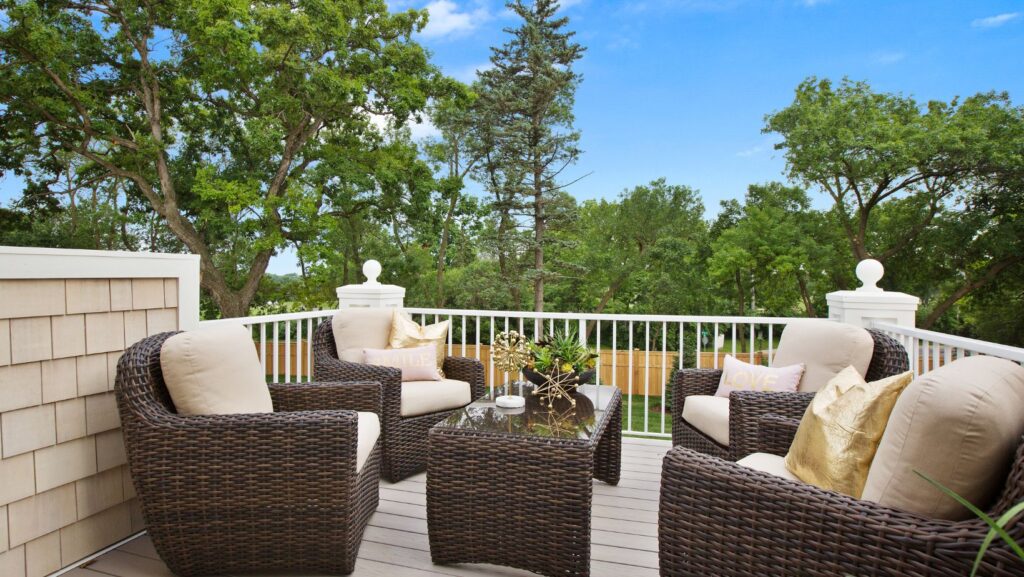Imagine transforming your backyard into a personal oasis, the perfect spot for hosting summer barbecues, or a cozy retreat for star gazing. A well-designed deck can do just that. With a dash of creativity and a sprinkle of DIY spirit, you can create a deck that’s not just functional, but also a reflection of your unique style.
DIY Deck Ideas

Embracing DIY deck ideas requires comprehending important aspects of deck construction. Reading through the basics, one familiarizes themselves with the types of decks and common materials used in their creation.
Decks flaunt various designs, each embodying a unique function. For instance, the Freestanding deck, separate from the house, serves as a lone structure, ideal for garden focal points or far-off areas from the house. On the other hand, the attached deck, as indicated by its name, binds to the house, resembling a patio, particularly useful for effortlessly accessing the yard from higher house floors.
|
Types of Decks |
Features |
|
Freestanding Decks |
Ideal for garden focal points, separate from the house |
|
Attached Decks |
Functions like a patio, easily accessed from house floors |
Materials Used for Deck Building

Building a deck involves various materials, with some of paramount importance. Natural wood, renowned for its aesthetic appeal, comes in several kinds. For instance, redwood or cedar, known for their richness and elegance, bring a natural touch to the deck. Conversely, pressure-treated lumber offers a less-expensive, durable choice, ensuring long-lasting use. Synthetic materials form another option. Composites, famed for their low maintenance, consist of a blend of plastic and wood particles. Unlike natural wood, composites resist warping and splintering, providing a uniform, sustainable design. Thus, material selection highly impacts not only the deck’s look but also its upkeep and durability.
|
Deck Materials |
Pros |
|
Natural Wood (Redwood, Cedar) |
Aesthetic appeal, natural touch |
|
Pressure-treated Lumber |
Cost-effective, durable |
|
Composites |
Low maintenance, resistance to warping and splintering |
Steps to Build Your Own DIY Deck
As discussed in the previous section, DIY deck ideas abound, igniting the imagination with limitless design possibilities. Moving past the conceptual stage to the actual construction, one realizes that a methodical approach necessitates planning, gathering tools and materials, and, finally, deck construction.
Planning Your Deck Design

The process of DIY deck building starts with effective planning. A thorough understanding of the deck’s purpose, its expected use, and examination of space available in the backyard are prerequisites. Assess variables such as the size of the deck, how it’ll connect to the house, and its accessibility from various parts of the house. For an accurate visualization of the deck, draft a scaled diagram that includes the house, the backyard, and the proposed deck layout. Placing markers in the backyard to outline the deck’s dimensions aids in refining the design before construction begins.
Lastly, researching local building codes and restrictions before starting the deck construction is critical. These codes could potentially influence the deck’s size, height, or railing requirements. Permit necessities vary from city to city and obtaining permits that align with city codes ensures a seamless and legal decking procedure.
Gathering Required Tools and Materials
Post finalizing the design; it’s time to assemble the necessary tools and materials for deck construction. Some generic tools required for a DIY deck project include hammers or nail guns, drills, saws, tape measure, level, and a carpenter’s square.
Choosing the right material for the DIY deck is the next imperative step. As mentioned previously, multiple material options exist like natural woods such as redwood or cedar, pressure-treated lumber for cost-effectiveness, or composite materials for easy upkeep. The selection ultimately depends on individual lifestyle, aesthetics, and maintenance preferences.
Constructing Your DIY Deck
With careful planning and required tools on hand, the primary stages of construction can proceed. Typically, the process begins with preparing the site, which involves clearing away any plants or obstacles. It then advances to setting the concrete footings, followed by installing joists using ledger boards for support. Decking boards are secured perpendicular to the joists, and finally, railings or steps are added if lacking.
Incorporating DIY deck ideas into a backyard demands patience and dedication. By understanding the basics of deck types, design planning, material selection, and construction procedures, one can confidently transform their outdoor living space.

